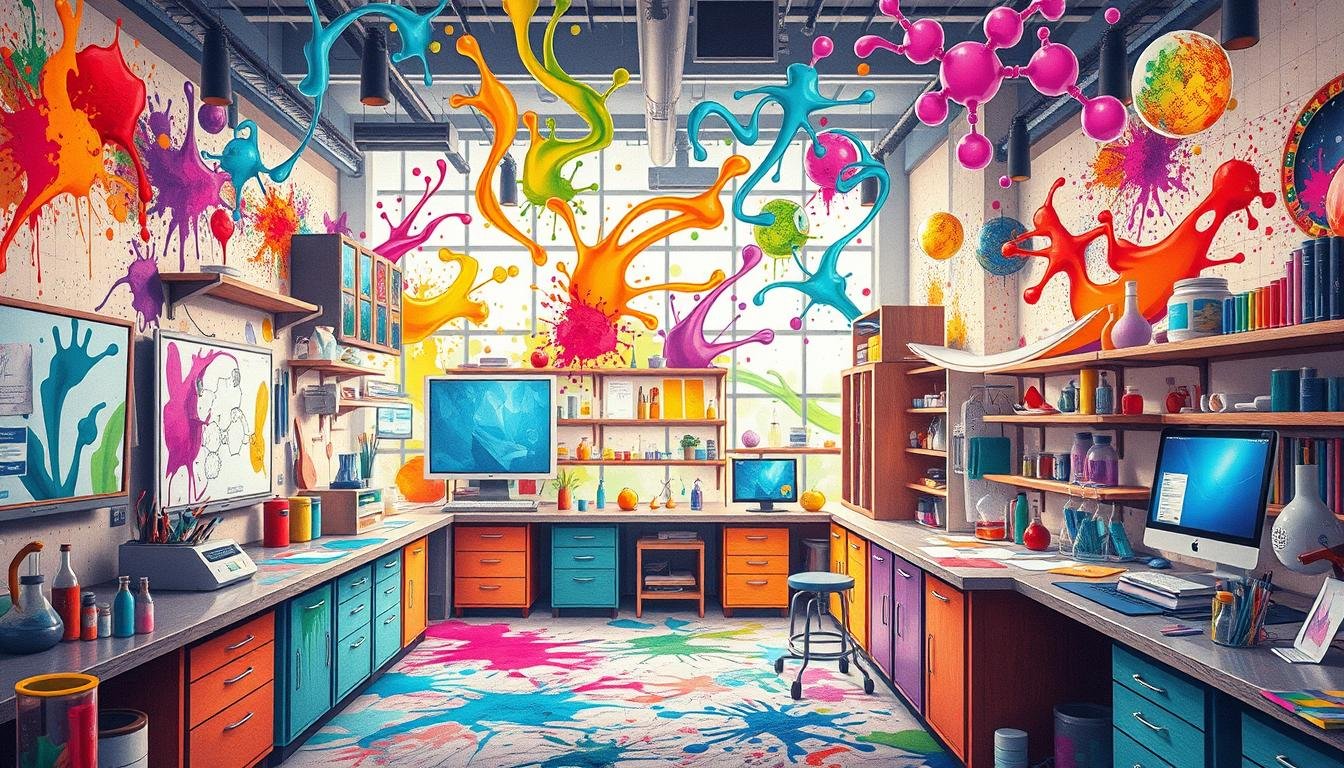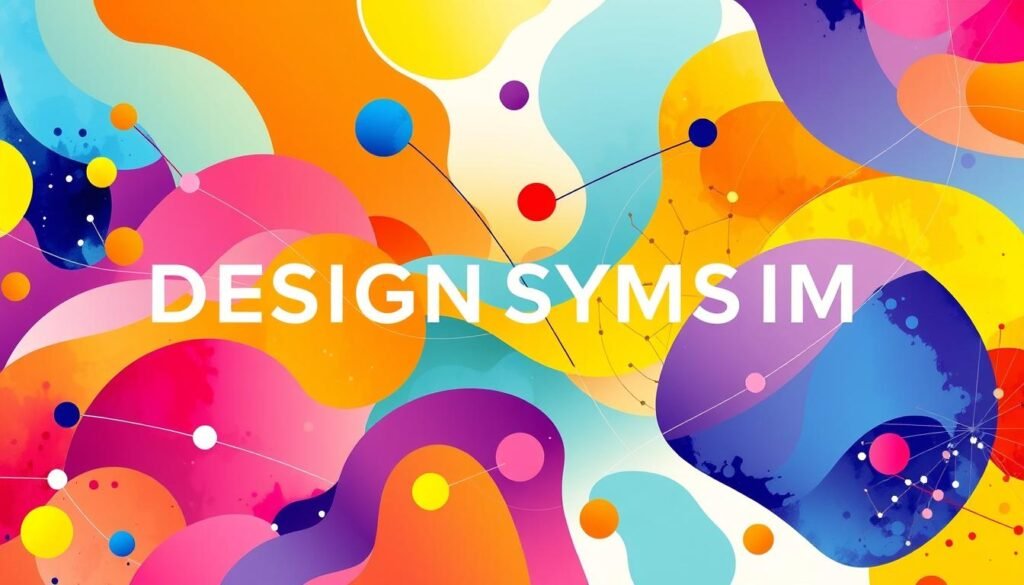

Innovative design mixes creativity with science for impressive results. This look into design chemistry shows how using chemistry in designing leads to great creativity. It opens up new areas of potential.
Design chemistry combines creative innovation with the structured methods of science. It makes design thinking more effective, leading to creative solutions in different areas.
Chemistry teachers find these methods make hard concepts easier to understand1. For instance, organic chemists build new compounds with great care. This can inspire designers to create with the same level of detail (source: research study).
New materials made by chemistry, like bendable electronics and strong composites, show how design chemistry pushes boundaries2.
Table of Contents
ToggleKey Takeaways
- Design chemistry blends creativity with scientific rigor to create innovative design strategies.
- Experienced chemistry educators effectively support students in integrating these strategies1.
- The study of organic chemistry is foundational to exploring creative potential in design1.
- Innovations such as flexible electronics highlight the impact of design chemistry2.
- Resources, such as the research article by Springer, offer valuable insights into the application of design chemistry.
Introduction to Design Chemistry
Design chemistry is more than a simple analogy. It artfully combines classic design with chemistry’s systematic approach. This blend leads to innovative problem-solving in design. It helps us deeply understand how important it is in creative work.
The Concept of Design Chemistry
Design chemistry involves a range of ideas and practices, much like school subjects. For example, the Discovering Design with Chemistry course talks about atoms, bonds, shapes, and heat3. These topics show how design chemistry brings different fields together. Starting from the basics, like in chapter 1 of textbooks, students learn 16 topics and do 3 experiments4. This foundation paves the way for deeper learning.
Importance in Creative Processes
Design chemistry plays a crucial role in creativity. It sparks new ideas and solutions, helping creators tackle tough problems. For instance, 46 experiments in certain courses3 show how hands-on work leads to breakthroughs. Also, detailed discussions in chapters, like the 27-page “What’s The Matter?” in Chapter 24, help learners grasp complex concepts in both design and chemistry.
The mix of theory and practice is key in analyzing design chemistry. This approach boosts the problem-solving and innovation skills of designers. By using these methods, designers face complex challenges head-on. This encourages a landscape ripe for innovation and effective solutions.
Understanding Design Chemistry Analysis
Design chemistry plays a big role in the creative process. It helps us understand key aspects and use them fully. This way, we go beyond just theory and make our workflow better.
Key Components of Design Chemistry
Design chemistry blends science and design beautifully. For example, Chapter 1’s 20 Comprehension Check Questions introduce measurement and math in design5. Also, working together brings out new ideas. STEAM-PjBL makes different subjects work as one, improving creativity. Nanotechnology is now part of chemistry, biology, and engineering. It shows how design and science are coming together more and more6.
Benefits of Design Chemistry Analysis
Analyzing design chemistry turns ideas into real designs. Chapter 1’s questions about density and conversions show how useful a data approach is5. Using design for sustainability gets easier. It matches design with new tech like energy storage and CO2 capture. This aims to reach carbon-neutrality by 20506. So, analyzing design chemistry makes work smooth and ideas new and doable.
Creative Exploration Methods in Design
The creative exploration process in design is iterative and dynamic, blending different methods. It’s key for making innovative and user-focused designs that solve real problems effectively.
Empathize: The Human-Centered Approach
Empathy is central to design thinking. It aims to understand users’ needs and feelings. By putting ourselves in the users’ shoes, we create solutions that truly click with them7. This involves talking directly to users, doing interviews, and engaging in immersion activities to gain deep insights.
Define: Identifying Core Problems
After getting to know the user’s perspective, the next step is to refine our insights into clear problem statements. This is vital for sparking innovation in design. It captures the problem’s essence, paving the way for targeted solutions8.
Ideate: Generating Innovative Ideas
The ideate phase lets creativity flow. Teams hold brainstorming sessions and workshops to think up many solutions. This stage aims to push the limits and think differently7.
Prototype: Building Functional Models
Prototyping turns ideas into real, testable models. Here, we make simple versions of solutions to see if they work. It’s a test field for design ideas, allowing for tweaks and improvements8. Early tests help spot what works and what doesn’t.
Test: Validating Solutions
The last step is testing with actual users. It checks if the designs are useful and easy to use. Getting user feedback and making changes are key parts of this phase7. By testing and refining, we enhance design potential and drive innovation.
Unveiling Innovative Design Strategies
Exploring new design strategies means understanding complex ideas like STEAM-PjBL. These focus on critical thinking and solving problems. They’re the backbone for guiding creative efforts and discovering new design methods.
Integration of STEAM-PjBL
Combining STEAM (Science, Technology, Engineering, Arts, and Mathematics) with Project-Based Learning (PjBL) boosts creativity. It encourages teamwork across different fields and links technology, science, and arts. It’s used in projects such as studying collagen stability and understanding protein folding9. These methods improve both knowledge and innovative thinking, crucial for creating new designs.

Adopting Cross-Disciplinary Approaches
Using cross-disciplinary methods in design pushes the limits and brings together various forms of knowledge. It leads to new insights and innovative solutions. It also ensures diverse viewpoints are considered in the creative process. A study showed a technique called CADD had a 35% success rate in pharmaceutics, much higher than traditional methods10. This shows the value of combining different fields for better results.
Also, targeted cancer treatments benefit from this approach by changing how cells interact9. Such strategies allow designers to tackle complex challenges and boost creativity.
Exploring new chemical spaces through pseudo-natural products opens up new possibilities in finding active compounds.9 By using a mix of techniques, creative minds can create an environment where innovation flourishes.
To truly benefit from innovative design strategies, it’s important to encourage teamwork and ongoing learning. This ensures that design practices evolve and stay relevant. For more on these strategies, check out additional information here10.
Critical Thinking in Design Chemistry
In design chemistry, critical thinking goes beyond looks. It is about deeply considering the project’s far-reaching effects. By diving into the surrounding issues, designers can spot hidden problems. This leads to smarter, new solutions. For instance, a study with 41 tenth graders in Rangkasbitung, Banten, Indonesia used sites like Edmodo and Zoom to boost learning and check critical thinking skills11.
To think deeply, one must really understand the surrounding issues and what their solutions might cause. How well they thought was measured by looking at how they defined problems, found solutions, adjusted plans, and looked back at their work11. This kind of deep thinking is super important in the real world of design. There, designers face complex challenges and must use their creativity wisely.
Developing a Reflective Approach
A reflective approach is about getting better over time and always checking your work. It involves searching for information and coming up with creative solutions logically and thoughtfully11. This way of thinking is supported by the design thinking steps: empathize, define, ideate, prototype, and test11.
Analyzing Contextual Problems
Understanding the issues in design chemistry is key. This analysis helps find the main problems and sets the stage for creative solutions. The study showed that students reached a high level of critical thinking in things like creativity and logic11.
Using these skills in a professional setting can really improve how design projects are managed. By adding STEAM-PjBL and design thinking into the mix, we challenge students. This prepares them for the skills needed in the 21st century11.
Discovering Design Chemistry
Design mixes art and science, creating a world called design chemistry. It shows how combining design principles leads to great results.
Designers learn to mix elements for better creativity by visiting creative climate in design. This mix makes design smooth, marrying art with science. Forty-six experiments showcase this blend, using both numbers and observation1213.
Courses aim to boost design innovative thinking. They cover atomic and molecular structures. Knowing these helps designers see how materials change, which is crucial for impressive designs12.
These teaching tools are big (11.25 × 8.75 × 1.5 inches). They cover many design topics, giving a deep understanding of design chemistry12. The strong hardcover adds to the learnings, merging science with creativity13.
Everything is made easy to use, yet it keeps high standards. The teaching style is easy to follow and liked by many12. Combining these elements correctly leads to new ideas and strong designs.
Design Chemistry Research Insights
Exploring how design teaching and chemistry research link up gives us valuable knowledge. It shows that when education mirrors real-world needs, people understand better and do better work. We will look into both studies and how they are used in the real world.
Documented Studies and Findings
The Division of Chemistry (CHE) kicked off an initiative in 2017 called Data-Driven Discovery Science in Chemistry (D3SC)14. This effort aims to use the surge of data to help chemical research14. It highlights the need for chemists and data experts to work together14. Also, the CAS SciFinder platform offers a well-organized database to speed up research15.
Real-World Applications
Putting these insights to use in the real world brings big benefits. For example, working with companies gets stronger by using grants like those from the GOALI14. CAS SciFinder makes finding new connections easier, leading to smart and green research solutions15. By mixing design savvy with data use, researchers solve big chemical problems more efficiently14.
These studies and applications show why linking design teaching with industry needs is crucial. By focusing on core and applied chemistry in education, future experts will be ready to solve complex issues.
Unlocking Design Potential
To unlock a brand’s design potential, strong strategies are key. These strategies boost creativity and develop effective processes. They help make designs innovative and engage people in the creative process. This is crucial for transforming brands.
Strategies for Enhancing Creativity
Encouraging divergent thinking is a great way to boost creativity. It lets people come up with lots of ideas without quick judgment. This environment is perfect for creating new designs. Tools like Definitive Screening Designs (DSDs) also play a big part. They improve project designs by identifying important factors early on. This reduces costs and makes workflows better16.
DSDs help in controlling factors and increasing the power of experiments16.
Implementing Effective Processes
It’s crucial to have systems that turn ideas into reality. The DIDOV Six Sigma process is a structured method. It makes sure every step, from the first idea to the final product, is well planned and carried out16. Using approaches from different fields can also make the creative process better. It leads to more creative design solutions.
Natural product research shows how old knowledge can improve modern design. Drugs from natural and synthetic sources show innovation comes from tradition17. In design, using diverse and historical insights can bring new ideas. This pushes the limits of what we can do in brand transformation.
Technology is also very important. For instance, using machine learning to find new materials shows how tech can drive innovation18. These techniques can be used in design for continuous innovation. Using advanced methods in design not only creates groundbreaking designs but also puts them into practice. This highlights the need for effective processes in achieving a brand’s creative goals.
Developing Design Concepts
Turning initial ideas into solid designs takes careful work. It’s vital for designers to create ideas that are new yet workable. To make these ideas real, you refine them step by step. This often involves getting feedback and making changes.
From Ideas to Tangible Designs
The first step is brainstorming to come up with many ideas. This is key for learning how to manage designs. In classes like Design Chemistry, students learn about atomic structure and more. This knowledge helps them think of new design solutions19.
Teachers guide, discuss, and show lab work to deepen understanding19. Then, to make ideas into real designs, you sketch and build models. You improve your designs by listening to feedback19.
Working together is essential in design development. It brings in different views and helps everyone aim for the same goal. In schools, students can team up for discounts, promoting working together19. This approach builds skills in solving problems together.
This way of learning prepares you for working with others professionally. Designers need to communicate well and tackle challenges together. This prepares them for a successful career in design.
Inspiration Techniques for Design Chemistry
Inspiration in design chemistry demands mixing different perspectives, trying new ideas, and working together. By doing these, teams can reach their highest creative levels. This also creates a space where everyone feels free to invent.
First, using diverse perspectives helps designers tackle problems from all sides. This makes team-based design systems stronger as everyone’s ideas are considered. Such variety can spark unique solutions that might not come from just one person’s view.
Next, it’s important to encourage exploration. When team members play with new materials or methods, they can discover amazing results. Being open to trial and error builds a place where making mistakes is okay, and innovation blooms.
Using team-based design tools makes sure everyone’s ideas are heard. These tools help combine everyone’s strengths, making way for creative breakthroughs. Tools like LiveDesign support this by improving design planning in fields like drug discovery20.
Also, having a set process with clear steps helps a lot. LiveDesign helps organize projects, making it easier to see progress and work smoothly with partners20. Organizing projects this way leads to success in design chemistry.
To keep innovation alive, learning new things is crucial. For example, LiveDesign’s online courses offer practical skills in modeling and predictions using AI20. This knowledge helps in achieving project goals.
Blending creativity with structured methods and using the latest tools enhances teamwork. It also keeps the creative environment thriving. Here’s a quick comparison of different techniques:
| Technique | Description | Benefits |
|---|---|---|
| Embracing Diverse Perspectives | Incorporating different viewpoints in the design process | Promotes innovation and problem-solving |
| Nurturing Spirit of Exploration | Encouraging experimentation and risk-taking | Leads to breakthrough ideas and solutions |
| Leveraging Collaborative Design Systems | Utilizing tools like LiveDesign for teamwork and idea capture | Enhances creativity and efficiency |
| Structured Processes | Implementing clear timelines and workflows | Ensures organized and effective project execution |
| Educational Resources | Providing online courses and hands-on learning | Improves skills and fosters continued innovation |
Managing Creative Processes in Professional Settings
Managing creative processes well is key for top results in professional graphic design. It’s important to keep in line with design standards and handle creative teams well. This fosters innovation and productivity. We’ll look at ways to mix creativity with limits and create a supportive environment.
Balancing Creativity and Constraints
It’s crucial to find the right mix between creativity and limits in graphic design projects. A 2008 Harvard Business School study notes that organizations should focus on creating conditions for creativity to bloom, not trying to control it directly21. This lets projects excel within set boundaries. Having a team with diverse views helps come up with fresh solutions21. Also, using different opinions to pick ideas with real business promise is key21.
Fostering a Creative Climate
Making a place where creativity grows is vital for design teams’ success. Google’s founders, Sergey Brin and Larry Page, found out ideas from the whole team work better than just from the top21. This shows the value of trying new things and taking risks without fear21. Keeping creative folks away from red tape helps their ideas shine, leading to success that fits design standards21. Lastly, applying efficiency measures when making ideas real, rather than when dreaming them up, balances creativity with practical needs21.
Design Synthesis Processes
Design is all about blending knowledge to make something whole and functional. In this process, beauty and usefulness come together. This mix is critical to keep designs looking good while being created.
Integrating Various Design Elements
Bringing different elements together is key. It means mixing materials, shapes, and tech. With synthetic chemistry, we can make materials that do new things22. Our big goal is to blend these well, focusing on being green and efficient23.

Achieving Cohesive Results
To get unified results, we pay close attention to each part. We use atom economy, where no atom is wasted, for less trash and more efficiency23. We also create new chemicals for better results, keeping creativity alive23.
Design synthesis is more than mixing stuff; it’s about understanding each piece. This ensures the final product is both nice to look at and works well. This method shows how vital it is to weave design knowledge into the whole creative process.
Conclusion
We are wrapping up our deep dive into design chemistry. It’s key for bettering the design exploration process. Through the article, we discovered various aspects of design chemistry. We revealed important insights and techniques that are vital for creative achievements.
Design chemistry makes us see creative work in a whole new light. We looked at exercises from “Discovering Design with Earth Science”24. We also explored how fields like biology and physics show design in nature25. These educational pointers help grow our ability to think critically. They show us the value of reviewing various contexts and perspectives26.
Learning design chemistry is more than just getting better methods. It’s about changing how we see design. It uplifts design practices by making us appreciate deep design connections. It pushes us to question the usual ways. Remember, diving into design chemistry opens doors to fresh and meaningful work.
FAQ
What is the concept of design chemistry?
Design chemistry is about mixing art and science to make something new. This approach uses the rules of design with the precision of chemistry to come up with creative ideas.
Why is design chemistry important in creative processes?
It pushes creativity forward by blending careful planning with sudden inspiration. This mixture solves tough problems and brings about fresh, smart solutions.
What are the key components of design chemistry analysis?
The main parts are mixing science with ideas, working together, and planning innovations. This turns theory into reality and improves creative work with solid facts.
How does empathizing help in the human-centered design approach?
Understanding what users truly need and feel is key. This insight leads to designs that work well and touch people’s hearts, making a bigger impact.
Why is the STEAM-PjBL framework important in innovative design strategies?
This framework boosts critical thinking and solving problems. It supports working across different subjects, which helps in creating stronger, more inventive designs.
How does critical thinking influence design chemistry?
It involves deep thinking about beauty and impact. This uncovers hidden problems and leads to smarter solutions, making designs richer.
What insights do design chemistry research studies provide?
Studies show how to use design chemistry in both school and work. They highlight critical thinking’s role and show how it changes different areas.
What strategies enhance creativity in design?
Creativity blooms in the right setting, with different views and a spirit of discovery. Using teamwork in design taps into everyone’s creativity.
Why is collaboration vital in developing design concepts?
Working together mixes unique ideas and skills, improving the design process. It smooths out rough ideas and tackles problems, creating complete, captivating designs.
What techniques can stimulate design inspiration?
Encouraging a creative atmosphere, open thinking, teamwork across fields, and using tools that bring out creativity are key to finding inspiration.
How can professional settings manage creative processes effectively?
It’s about mixing imagination with real-world limits. Creating a supportive space, following professional standards, and using strong management skills are essential.
What is involved in the design synthesis process?
It’s about blending design elements and keeping aesthetics in mind while guiding the creative journey. This makes sure the final design stands out, works well, and has an impact.

As a trusted news source, Editorial Fox prides itself on upholding the highest standards of journalistic integrity. Our commitment to accuracy and fairness ensures that our readers can rely on us for reliable information.
Mail: info@editorialfox.com
About Editorial Fox
At Editorial Fox, we are committed to delivering high-quality journalism that informs and engages our readers. Our team of experienced journalists and editors work tirelessly to bring you the latest news and analysis from around the world.
Copyright @2024 Editorialfox.com All Right Reserve.


Be the first to leave a comment